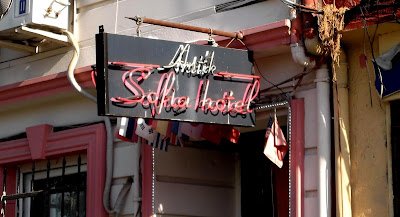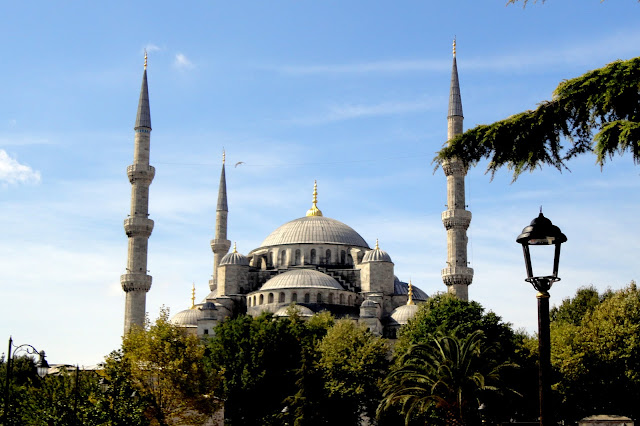My first contact with Turkey was made in Istanbul, more precisely the Atatürk International Airport. I arrived in the night what could make using the public transportation to reach the hotel a bit complicated - so I decided to book a
transfer from the airport to my hotel. Once I arrived, I tried to withdraw money - Turkish Lira - but the ATM gave me errors instead. Twice. I later knew that I shouldn't have asked for a receipt, hence the error. Even though I had no success getting the money, the full amount was discounted from my bank account, and it took two longs weeks and inumerous phone calls to solve the problem.
As soon as I left the arrivals area of the airport, there was a man waiting for me and my mate, and took us to the hotel -
Antik Sofia Otel. Because the hotel is located in a family neighborhood in the historical district of Sultanahmet, we really could feel the ambiance of life in Istanbul - although it was a bit small, the owner and the location were just right, so if you are on budget I would recommend it. Hearing the callings for praying from the old mosque at 5 am has it charm.
 |
| The Antik Sofia Hotel |
 |
| The Küçuk Ayasofya Mosque - formerly the Church of the Saints Sergius and Bacchus - right in front of the hotel. |
Since we only had 2 days, more specifically one full day and a morning to see the entire area, I planned the trip in advance - we only visited Sultanahmet, but went to the most eye-catching places. We were really close to the touristic area, so we walked all the way without taking transports.
The first stop was the
Hippodrome - a big square right next to the Blue Mosque. In the ancient times it was the heart of Constantinople's political and sporting life. Now it's called the "
At Meydanı" (Horse Grounds) because of its function in Ottoman times. Travel guides says that there is free wifi - I couldn't access a free network though. The Hippodrome has several monuments:
 |
| The Thutmose Obelisk in the hippodrome |
- Serpent Column - All that remains is the base, the column was cast to celebrate the victory of the Greeks over the Persians during the Persian Wars in the 5th century BC. Constantine ordered the Tripod to be moved from the Temple of Apollo at Delphi, and set in middle of the Hippodrome. Parts of the heads were recovered and are displayed at the Istanbul Archaeology Museum.
- Obelisk of Thutmose III - brought by emperator Theodosius in 390, the obelisk from Egypt was erected inside the racing track. Carved from pink granite, it was originally erected at the Temple of Karnak in Luxor during the reign of Tuthmosis III in about 1490 BC. Theodosius had the obelisk cut into three pieces and brought to Constantinople. The top section survives, and it stands today where Theodosius placed it, on a marble pedestal. The obelisk has survived nearly 3,500 years in astonishingly good condition.
- Walled Obelisk - built in the 10th century the Emperor Constantine Porphyrogenitus. It was originally covered with gilded bronze plaques, but they were sacked by Latin troops in the Fourth Crusade.
 |
| The Walled Obelisk |
Since the Hippodrome is close to the main touristic places - Hagia Sophia, Topkapı Palace, the Blue Mosque and the the Basilica Cistern, we could easily choose what to visit next. We decided that the next stop would be Hagia Sophia (Ayasofya in Turkish) - since we were there early, about 9 am, we could enter the museum without having to wait too much. And that was wise since a few hours later the queue was several meters long! The entrance costs 25 TL, but it's well worth it - this building is almost 1500 years old, being built as a church in 537 AD. It was proclaimed a mosque soon after the conquest of the city from the Byzantines in 1453. When it was transformed into a mosque, the christian mosaics were covered in plaster but not destroyed. It served as Istanbul's most revered mosque until 1935 when Atatürk, recognizing its world-historical significance, had it proclaimed a museum, as it is now. Most of the 30 million gold mosaic tiles which cover the church's interior—especially the dome—have recently been restored.
 |
| Hagia Sophia in the early morning |
 |
| Hagia Sophia by night |
 |
| The amazing mosaics from the time when it was a church |
 |
| The interior of the museum |
When you leave Ayasofya you can turn left, and then left again to see the
Sultan Tombs. The entrance is free, and there isn't much to see here except for... tombs. The entrance is free, so if you have the time take a look. The mausoleums are decorated with an Arab style and you'll have to take your shoes off to enter. If you like history you'll see the tombs lots of well-known sultans.
 |
| The interior of one of the mausoleum |
Right in front the tombs and Ayasofya is the
Blue Mosque, also called the
Sultanahmet Camii. It earned its name because of the blue interior tiles. Being one of Istanbul's premier sights, we had to wait in the queue for a bit. Since it's a working mosque, you can enter for free (though donations are gratefully received at the exit). It's closed to non-worshippers for a half hour or so during the five daily prayers, and may be closed for a longer time from midday on Friday, the Muslim holy day. At the entrance we were asked to put our shoes in a plastic bag, and the ladies who had her beautiful legs too exposed were asked to cover them with a scarf. The interior of the mosque was astonishing - being my first time on a real mosque, I was really impressed. There are no statues like in the catholic churches, just a big open space with a carpet. The interior is really well adorned as you can see from the pictures.
 |
| The interior of the Basilica Cistern with its 336 marble columns taken from pagan temples in Anatolya |
Aaaand it's enough for this post, don't forget to see
part 2 ;)















No comments:
Post a Comment